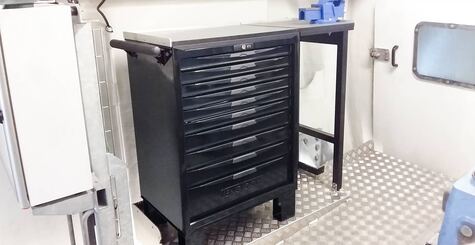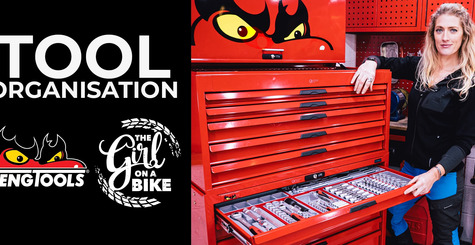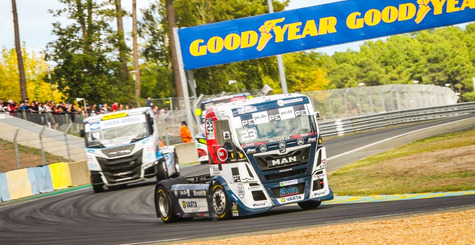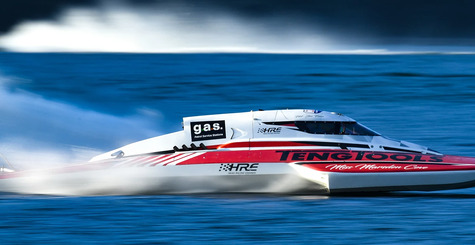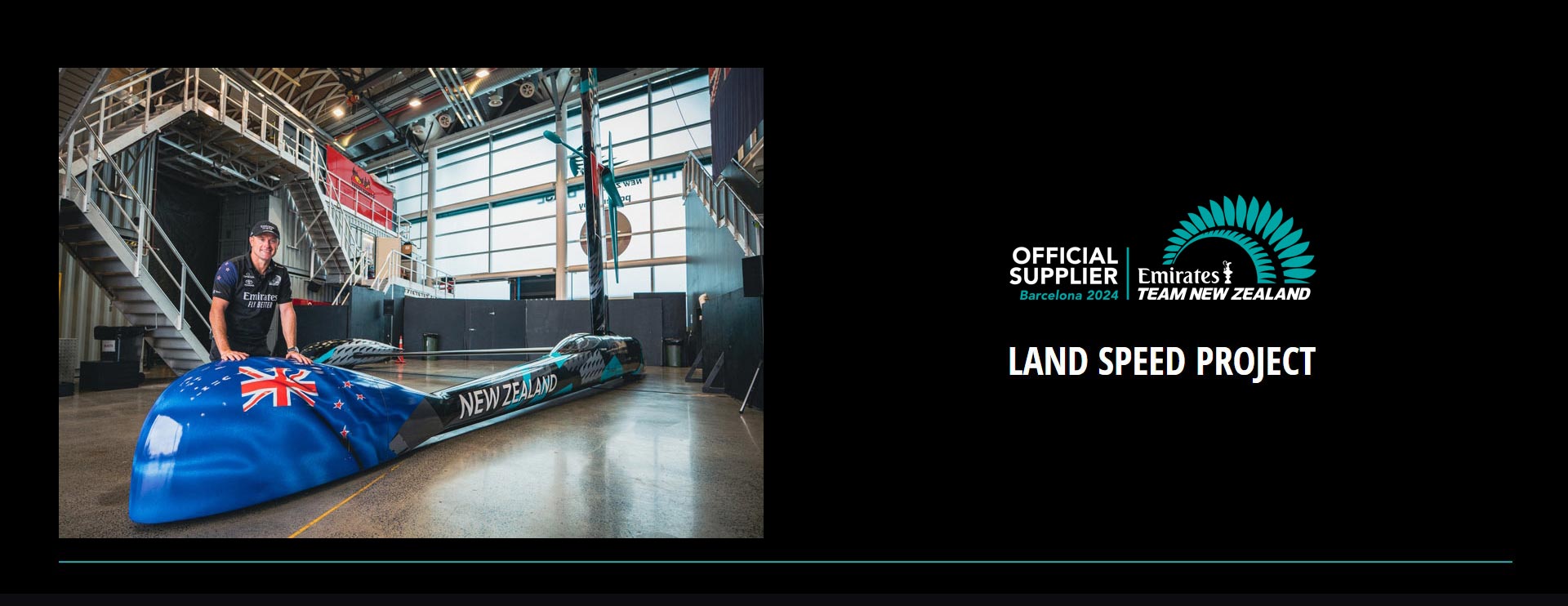
Story / 18/12/2023
Breaking barriers - The world wind-powered land speed record
Glenn Ashby’s move from sailing to chasing the world wind-powered land speed record opened a new and significant chapter for Emirates Team New Zealand. The transition from an aquatic to a land-based challenge meant embarking on a project that turned out to be laden with logistical and environmental obstacles that put their adaptability and resilience to the test. In the arid surroundings of Lake Gairdner, the team found that the changeable weather conditions on land were as unpredictable as those they had learned to master at sea.
All images: © Emirates Team New Zealand, © Emirates Team New Zealand / James Somerset
A journey from water to land
Glenn Ashby, born in 1977 in Bendigo, Australia, grew up in a family passionate about sailing. This early exposure laid the foundation for his remarkable sailing career, marked by three America’s Cups, an Olympic silver medal, and 17 World Championships across four boat classes. Ashby’s lifelong fascination with speed and boundary-pushing technology has been a driving force behind his achievements. As a child, experimenting with skateboards and bedsheets to create makeshift sails and billy karts in the water-scarce region of central Victoria, Ashby’s ingenuity was evident.
After a decade with Emirates Team New Zealand, Ashby found himself yearning for a new challenge: to go after the World Wind-powered Land Speed Record. The ambitious plan was proposed to his team in October 2020. This stand-alone project, under the Emirates Team New Zealand umbrella, would bridge the downtime between America’s Cup events and serve as a platform to propel design and challenge technological limits in high-speed domains. Venturing into the territory of land-based aerodynamics and engineering marked a notable deviation from their expertise in hydrodynamics.
Following the team’s victory in the 36th America’s Cup in March 2021, the path was set for this ambitious endeavour. By June 2021, with the robust support from team principal Matteo De Nora and CEO Grant Dalton, Ashby got the green light he needed to press on, and the project evolved from concept to reality. A dedicated core team, including naval architects Guillaume Verdier, Romaric Neyhousser, and Benjamin Muyul, alongside engineers Jeremy Palmer, Romain Gard, Tim Meldrum, Adrian Robb, Jarrod Hammond, and shore crew members Sean Regan and Dave French, were assembled.
The innovative engineering of 'Horonuku'
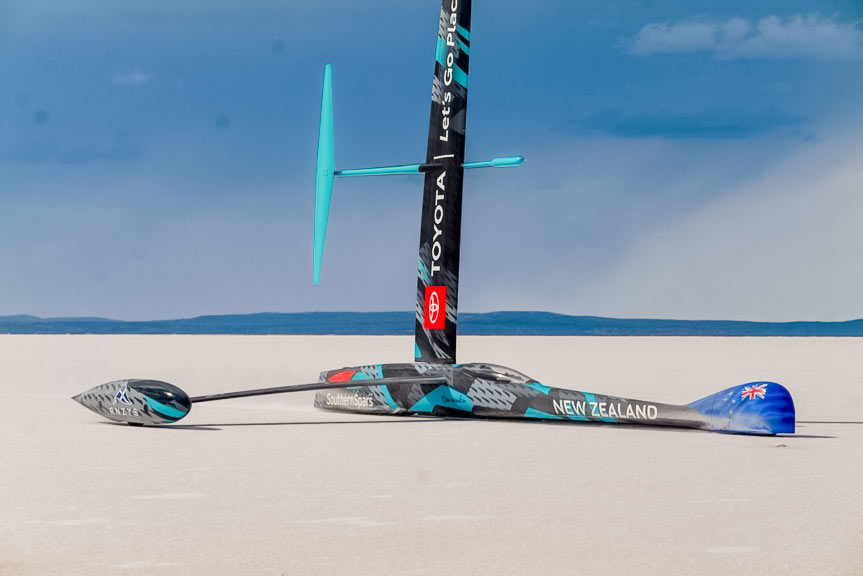
© Emirates Team New Zealand / James Somerset
The mission was to engineer an innovative craft poised to make history as the fastest wind-powered vessel, outpacing the current wind-powered speed record of 202.9 km/h by Richard Jenkins in 2009. The yacht had to be propelled by wind, initiated by a human push, and it needed to maintain a speed exceeding the existing record by over 1 mph for a minimum of three seconds. To meet these criteria, an extraordinary 14-meter land yacht named ’Horonuku’ (meaning ‘gliding swiftly across the land’) was built from carbon composite materials.
The wing of the craft functions as the ’engine’, solely responsible for generating speed. Comparable to the wings of an airplane or a glider, it’s designed to create lift. The flap on the 10 square meter tail wing, which extends from the back of the main wing section, adjusts the angle of the main wing in response to the wind, thereby producing the driving force. This feature allows the wing to automatically adjust itself to slight changes in wind direction, maintaining an optimal angle. This self-trimming capability enables the pilot to concentrate on navigation without constantly adjusting the wing.
Unique terrain as the record venue
As a venue, Lake Gairdner was selected for its remarkable flatness, geographical features and (usually) stable surface conditions which makes it suitable for high-speed activities. Located in a remote area far northwest of Adelaide, the journey to this remote salt lake involves traversing rugged outback roads. The lake, over 160 km in length, is covered in a thick salt crust that provides a reliable ”race area” that is more appropriate for speed trials than the northern parts of the lake, where the salt crust is too thin for any type of vehicle.
Overcoming production challenges
The team’s journey towards the record attempt was anything but smooth. By March 2022, the team grappled with looming logistical hurdles. Although the team was accustomed to high-pressure production and the task of churning out countless components, the addition of tight timelines further compounded the situation. Additionally, the ongoing pandemic could potentially derail supply chains and lead to staff shortages if team members were forced into isolation. Recognizing the volatile landscape of production uncertainties, Sean Regan, the team’s production lead, spearheaded a strategy of adaptability. The team remained nimble, tweaking their schedules and processes to stay on track. Despite the challenges the project continuously gained momentum, the various components of the Horonuku craft were coming together for the imminent launch.
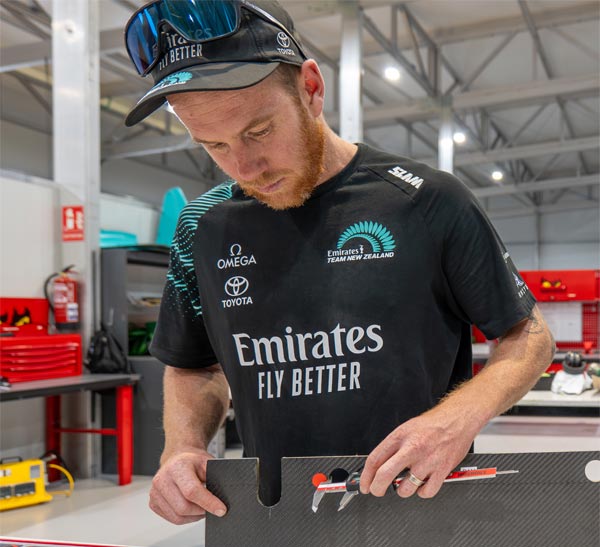
© Emirates Team New Zealand
The plan was for a mid-2022 record attempt. Pandemic travel restrictions had kept Ashby confined to Australia, but in May he could finally go to New Zealand to complete the last testing phase. Yet, the project’s fate was hinged on the whims of nature at Lake Gairdner. What the team did not know is that they were about to experience some unexpected adversity. The month of July presented a peculiar anomaly, as the typically barren salt lake was unexpectedly drenched, accumulating 50mm of water across its vast terrain.
Weather woes at Lake Gairdner
In 2022, Australia experienced record-breaking rainfall. This unrelenting wet season, particularly severe across central and eastern regions, transformed Lake Gairdner into an unsuitable venue for the record attempt. The persistent rain thwarted their plans, with repeated instances of the lake’s surface being inundated just as conditions seemed to be improving. The team faced a series of setbacks as each hopeful forecast for clear skies and strong winds was quickly overshadowed by more rain. This pattern of fluctuating weather conditions - a dry surface followed by rain and then brief drying periods - continued to hamper their efforts. Despite some days showing promise with ideal winds, the presence of water on the lake’s surface rendered it impossible for the attempt.
Frustration mounted as the team endured these continuous delays, with their hard work and preparation being repeatedly undercut by the unpredictable weather. The situation reached a point where, after months of waiting and watching, the team had no choice but to postpone their record attempt, storing ’Horonuku’ while hoping for the lake to dry out with the upcoming warmer weather. In hindsight, they couldn’t have picked a worse time for the wind powered land speed world record attempt.
Record attempt triumph amid adversity
In anticipation of the ideal weather, the team tirelessly refined and adjusted the craft, optimizing for speed and enhanced grip on the challenging surface of the lake. This period of strategic enhancements and test runs led to substantial improvements. Despite the setbacks posed by the weather, they now knew that when the perfect wind conditions finally presented themselves, they would be ready to seize the moment.
In early December, the long-awaited shift in weather finally arrived. The team, responsive and eager, quickly mobilized to the lake, now dry and with promising conditions. The weekend of December 10-11 presented its own set of challenges, with fluctuating wind directions and the looming threat of rain and thunderstorms. Saturday’s winds were sporadic and weaker than needed, but the team held onto hope for stronger winds on Sunday.

© Emirates Team New Zealand / James Somerset
Despite rain nearby and diminishing winds in the forecast, the team kept a keen eye on the conditions, ready to make their move. On December 11 a long-awaited window of opportunity finally emerged. The Emirates Team New Zealand with Glenn Ashby at the helm, swiftly responded and managed to accelerate ’Horonuku’ to an extraordinary 222.4 km/h powered by a 22-knot wind, shattering all former records.
Synergy of teamwork when pioneering technologies
While this achievement was a moment for celebration, the team recognized it as a step towards even greater goals. Their ambition extended beyond merely breaking the record. It was about paving the way for the technologies of tomorrow by pushing the limits of aerodynamics, structural forces, construction methods, and materials to their utmost capacities.
Regardless of preparation or technological advancements, success like this is unattainable without a phenomenal team and a touch of favor from Mother Nature. The collaboration, expertise, and perseverance of the team, coupled with the essential cooperation of the elements, were the true driving forces behind this remarkable achievement.
For information about TengTools products, please contact:
Colin Hodges
ISL Industrial Limited
40 Crooks Road
East Tamaki Auckland
+64 9 274 7365
sales(AT)isl.nz
Topic in this article
Story

 Ireland
Ireland
 Australia
Australia
 Austria
Austria
 Belgium
Belgium
 Denmark
Denmark
 Estonia
Estonia
 Finland
Finland
 Germany
Germany
 Italy
Italy
 Latvia
Latvia
 Lithuania
Lithuania
 Netherlands
Netherlands
 New Zealand
New Zealand
 Norway
Norway
 Poland
Poland
 Portugal
Portugal
 South Africa
South Africa
 Spain
Spain
 Sweden
Sweden
 Taiwan
Taiwan
 United Kingdom
United Kingdom
 USA
USA
